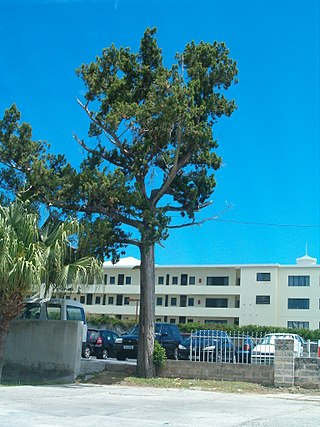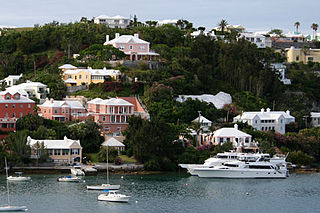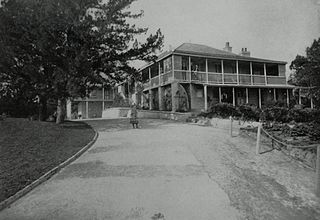
Bermuda is a British Overseas Territory in the North Atlantic Ocean. The closest land outside the territory is in the American state of North Carolina, about 1,035 km (643 mi) to the west-northwest.

Bermuda was first documented by a European in 1503 by Spanish explorer Juan de Bermúdez. In 1609, the English Virginia Company, which had established Jamestown in Virginia two years earlier, permanently settled Bermuda in the aftermath of a hurricane, when the crew and passengers of Sea Venture steered the ship onto the surrounding reef to prevent it from sinking, then landed ashore. Bermuda's first capital, St. George's, was established in 1612.
This is a demographyof the population ofBermuda including population density, ethnicity, education level, health of the populace, economic status, religious affiliations and other aspects of the population, including changes in the demographic make-up of Bermuda over the centuries of its permanent settlement.

Bermuda is an overseas territory of the United Kingdom in the North Atlantic Ocean. Located off the east coast of the United States, it is situated around 1,770 km (1,100 mi) northeast of Miami, Florida, and 1,350 km (840 mi) south of Halifax, Nova Scotia, west of Portugal, northwest of Brazil, 1,759 km (1,093 mi) north of Havana, Cuba and north-northeast of San Juan, Puerto Rico. The nearest landmass is Cape Hatteras, North Carolina, about 1,030 km (640 mi) west-northwest, followed by Cape Sable Island, Nova Scotia, Canada 1,236 km northward. Although commonly referred to in the singular, the territory consists of approximately 138 islands, with a total area of 57 km2 (22 sq mi).

Rideau Hall is the official residence of the governor general of Canada, the representative of the monarch of Canada. Located in Ottawa, the capital of the country on a 36-hectare (88-acre) estate at 1 Sussex Drive. The main building consisting of approximately 175 rooms across 9,500 square metres (102,000 sq ft), and 27 outbuildings around the grounds. Rideau Hall's site lies just outside the centre of Ottawa. It is one of two official vice-regal residences maintained by the federal Crown, the other being the Citadelle of Quebec.

Government House, colloquially known as Yarralumla, is the official residence of the governor-general of Australia. It is located in the suburb of Yarralumla in the Australian capital city of Canberra, in the Australian Capital Territory. The main residence is set amid 54 hectares of parkland. The house and its associated grounds were added to the Commonwealth Heritage List on 22 June 2004.

The City of Hamilton, in Pembroke Parish, is the territorial capital of the British Overseas Territory of Bermuda. It is the territory's financial centre and a port and tourist destination. Its population of 854 (2016) is one of the smallest of any capital city.

Royal Lodge is a Grade II listed house in Windsor Great Park in Berkshire, England, half a mile north of Cumberland Lodge and 3.2 miles (5.1 km) south of Windsor Castle. The site of homes since the 17th century, the present structure dates from the 19th century, and was expanded in the 1930s for the then Duke of York, the future King George VI. Its central section consists of three storeys, with two-storey wings, totalling about 30 rooms, including seven bedrooms. The Royal Chapel of All Saints was built on the grounds in the 1820s.

Thatched House Lodge is a Grade II-listed building, dating from the 17th century, in Richmond Park in the London Borough of Richmond upon Thames in London, England. It was the home of British prime minister Sir Robert Walpole and, since 1963, has been a royal residence, being leased from the Crown Estate by Princess Alexandra, The Honourable Lady Ogilvy, and, until his death in 2004, her husband, Sir Angus Ogilvy.

The Hamilton Princess & Beach Club, A Fairmont Managed Hotel is one of the grandest and most famous hotels in Bermuda, located in Pembroke Parish just outside the City of Hamilton. It also happens to be the oldest hotel in the Fairmont chains. One of the largest in Bermuda, it has over 400 rooms. It is one of two Fairmont Hotels on the island, the second being the Fairmont Southampton, which was originally opened as the Southampton Princess.

The governor of Bermuda is the representative of the British monarch in the British overseas territory of Bermuda.

Government House is the heritage-listed vice-regal residence of the governor of New South Wales. It is located on Conservatorium Road in the Sydney central business district, adjacent to the Royal Botanic Garden, and is situated south of the Sydney Opera House, overlooking Sydney Harbour. Constructed between 1837 and 1843, the property has been the primary vice-regal residence of the Governor since Sir George Gipps, except for two brief periods; the first between 1901 and 1914, when the property was leased to the Commonwealth of Australia as the residence of the Governor-General of Australia, and the second from 1996 to 2011.

Juniperus bermudiana is a species of juniper endemic to Bermuda. This species is most commonly known as Bermuda cedar, but is also referred to as Bermuda juniper. Historically, this tree formed woodland that covered much of Bermuda. Settlers cleared part of the forest and the tree was used for many purposes including building construction and was especially prized for shipbuilding. Scale insects introduced during the Second World War construction of United States airbases in Bermuda devastated the forests, killing over 99% of the species. Since then, the salt tolerant Casuarina equisetifolia has been planted as a replacement species, and a small number of Bermuda cedars have been found to be resistant to the scale insects. Populations of certain endemic birds which had co-evolved with the tree have plummeted as a result of its demise, while endemic cigalas and solitary bees were driven to extinction.

The architecture of Bermuda has developed over the past four centuries. The archipelago's isolation, environment, climate, and scarce resources have been key driving points, though inspiration from Europe, the Caribbean and the Americas is evident. Distinctive elements appeared with initial settlement in the early 17th century, and by the second half of that century features that remain common today began to appear.

The following is an alphabetical list of topics related to the British Overseas Territory of the Bermuda Islands.

Lieutenant General Sir George Mackworth Bullock, was an officer of the British Army. He served during the First World War, rising to the rank of lieutenant general, and was also the 108th civil Governor and military Commander-in-Chief of Bermuda.

A Virgin Paradise is a lost 1921 American silent adventure film produced and distributed by Fox Film Corporation and starring serial queen Pearl White, for who it had been written by her friend Hiram Percy Maxim. It was directed by veteran director J. Searle Dawley, and filmed near Harrington Sound in the British Imperial fortress colony of Bermuda, 640 miles off North Carolina where Searle had previously filmed The Relief of Lucknow and For Valour in 1912. Animals, including monkeys and lions, were imported for the production. On 21 December, 1920, Dawley received a cable at 8:25 AM at the Princess Hotel urging that White, who had previously visited Bermuda in 1913, leave Bermuda that day for New York aboard the RMS Fort Victoria. As the ship had already departed from the City of Hamilton, she was flown by a seaplane of the Bermuda and West Atlantic Aviation Company from the Princess Hotel to board the ship at Murray's Anchorage before it passed through Hurd's channel onto the open Atlantic Ocean. White was photographed boarding the seaplane by the proprietors of the Bermuda and West Atlantic Aviation Company, Major Henry Hamilton "Hal" Kitchener and Major Harold Hemming.

Admiralty House, Bermuda, was the official residence and offices for the senior officer of the Royal Navy in the Imperial fortress colony of Bermuda, originally the Commander-in-Chief of the North America and West Indies Station.
Royal tours of Antigua and Barbuda by its royal family have been taking place since the 20th century. Elizabeth II, Queen of Antigua and Barbuda, visited the country thrice: in 1966, 1977, and 1985.



















